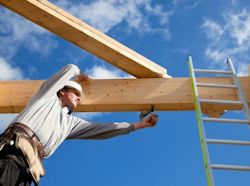Fall Hazards
Definition
Fall hazards are present at most worksites, and many workers are exposed to these hazards on a daily basis.
A fall hazard is anything at your worksite that could cause you to lose your balance or lose bodily support and result in a fall. Any walking or working surface can be a potential fall hazard.
Any time you are working at a height of four feet or more, you are at risk. OSHA generally requires fall protection be provided at four feet in general industry, five feet in maritime and six feet in construction. However, regardless of the fall distance, fall protection must be provided when working over dangerous equipment and machinery. The importance of fall protection cannot be stressed enough.
Falls from heights are the leading cause of fatalities in construction, while falls on the same level (slips and trips) are one of the leading causes of injuries.
Some of the working conditions that contribute to fall hazards include: unprotected edges of elevated work surfaces, including roofs, scaffolds, and ladders, unprotected roof edges, roof/floor openings, and structural steel & leading edges.
Examples
Fall hazard incidents are injuries produced by impact between the injured person and the source of injury when the motion producing contact was generated by gravity.
Fall hazards in construction cause accidents such as the following:
- A makeshift scaffold collapsed under the weight of four workers and their equipment, seriously injuring all four.
- A worker carrying a sheet of plywood on a flat roof stepped into a skylight opening and fell to the level below.
- A roofer, while attempting to remove a roof opening cover, fell approximately 21 feet to the concrete floor below and was killed.
A 51-year-old painting contractor at a residential apartment complex stepped onto a unsecured third-floor balcony, causing him to fall 21 feet onto the concrete below. As he lay injured, the balcony slid off its wall mount and landed on top of him. He died from his injuries.
An investigation by OSHA determined neither the contractor or subcontractor in this case had placed the required warning sign to alert the worker of the danger, and they had not tested the balcony's structural integrity or strength.
Hazard warning signs must be displayed and balconies, exits and high-level platforms must be blocked where practical during construction to prevent workers falling from heights or into active construction zones.
OSHA recommended the contractor and subcontractor pay substantial penalties.
Knowledge Check Choose the best answer for the question.
1-1. OSHA generally requires fall protection be provided at _____ in construction.
You forgot to answer the question!

